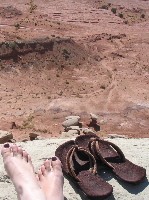AstroVino #7: Cabernet Sauvignon and Merlot
Last week's wine tasting focussed on the red wine of the Bordeaux region of France, specifically Cabernet Sauvignon and Merlot. These are the wines around which much wine lore has developped: that there are legendarily "good" years (like 1945 and 1961) and that wine has to be stored and such&such temperature for exactly so long before drinking. Cabernet Sauvignon is usually expected to age at least 5 years, if not 10 or more. These are also the wines that can get really really expensive. French wine labels are also notoriously difficult to understand (for example, in 2005 a survey was taken of the French population, and 72% of them couldn't parse the label on a typical wine bottle), so I won't really go into all of the descriptions here and now ... except for one little tidbit. Back in the day (mid 1800s), Napoleon III decided, for whatever reason, to have the winemakers of the Bordeaux region ranked. These rankings are still in use today, so a Premier Cru (1er Cru) is going to be among the most expensive and rarest wines around, on down to the 5ème Cru and the "Cru Bourgeois." Our first wine of the evening, a 2003 Château Potensac from Médoc, France was a Cru Bourgeois and right at the top of our price range; apparently any of the actually ranked 1–5 Crus are worth buying a wine cellar and holding on to for a while ... and if anyone ever offers you one, stop what you're doing, say "thank you," and listen to whatever it is they have to say.
We also had three other Cabernet Sauivignons: a 2001 Oberon Cabernet Sauvignon from Napa Valley, California; a 2004 Jim Berry The Cover Drive Cabernet Sauvignon from Clare Valley, South Australia; and a 2004 Montes Alpha Cabernet Sauvignon Apalta Vineyard from Colchagua Valley, Chile. Others at the tasting claimed that the Jim Berry was "jammy," like berries, and that the Montes Alpha had hints of "vanilla and chocolate," but all four tasted quite the same to me. Quite good and very tasty, but quite the same. Cabernet Sauvignons are apparently quite good with steak, but do not hold up well against fatty or spicy foods.
Our other two wines of the evening were Merlots, which have been grown and marketted so that they are easier to deal with than the complex store-in-the-cellar-for-a-decade Cabernet Sauvignon: a Merlot is a much safer and easier option for "I want something to drink tonight." We tried two: a 2002 Sebastiani Merlot from Sonoma County, California (which is actually 79.0% from the Merlot grape, plus a smattering of Cabernet Sauvignon, Zinfandel, Syrah, Cabernet Franc, and "other reds") and a 2004 Wolf Blass Yellow Label (100%) Merlot from South Australia. My only smiley face for the evening went to the Wolf Blass; it was slightly spritzy and very fruity. The Sebastiani was a tad too tannic for my tastes, but still yummy. Supposedly these Merlots are more "velvetty" and "softer" than their Cabernet Sauvignon cousins, but even after being told so, I found the reverse to be true.
All said, I very much enjoyed all of these wines (it was only the second week I have finished all of my portions), but perhaps all of the fuss made over French wines and their dauntiness—while perhaps having some validity—isn't quite all it's made itself out to be.


No comments:
Post a Comment